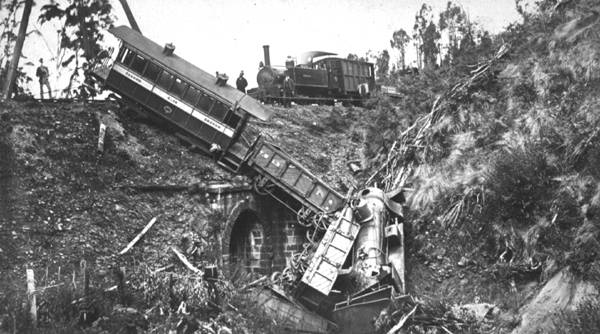 |
 |
|
Railway Accidents
Railway accidents in Tasmania's 133 years of railways have been remarkably few, in view of difficult operating conditions occasioned by hilly terrain. Successions of sharp curves on steep gradients occur particularly between Brighton and Rhyndaston on the line between Hobart and Launceston and this is where most accidents have occurred. The first, only six months after the line opened, was caused by a defective rail on Coal Mine Bend. Three people were injured. Fewer than ten accidents, statewide, caused one or two deaths; that about three miles north of Campania in 1916 was exceptionally serious, with 86 injured and seven fatalities. The express to Hobart, hauled by an M Class Garratt articulated locomotive, derailed on a horseshoe bend and overturned. The driver, Louis Goodchild, trapped in the cab, made heroic efforts to shut off escaping steam and was scalded to death.
Serious derailments have been mainly the result of washaways or excessive speed (however caused), but three had unusual causes. In 1897 one of the few accidents on the west coast occurred when the boiler of a locomotive at Zeehan station exploded, fortunately away from waiting passengers. The six-ton projectile rose 100 feet into the air and flew 150 yards. The driver and firemen were killed. In 1886 an express to Hobart overturned on the Bridgewater Bridge because the swing span was partly open. The locomotive struck a dolphin (wooden piling) and remained on the bridge, but the fireman and a passenger drowned after falling into the river. In 1950 and 1962 spectacular derailments occurred in Burnie when steam-hauled ore trains ran away on the steep grade on the Emu Bay Railway approaching the city. Further reading: T Cooley, Railroading in Tasmania, Hobart, [1963]. Graham Clements |
Copyright 2006, Centre for Tasmanian Historical Studies |

